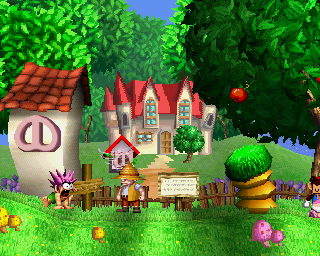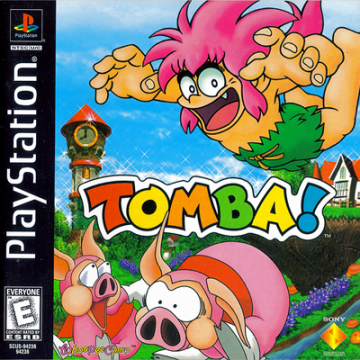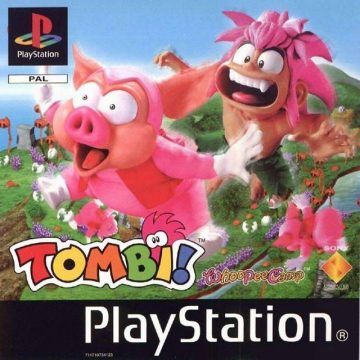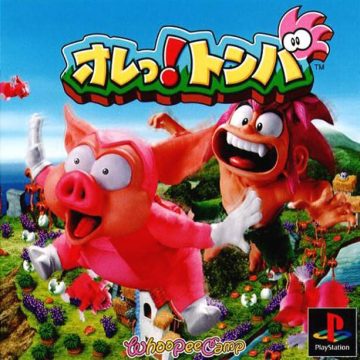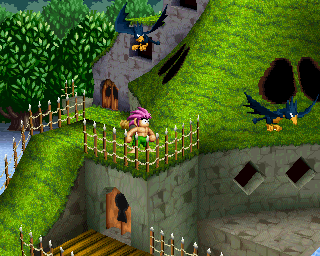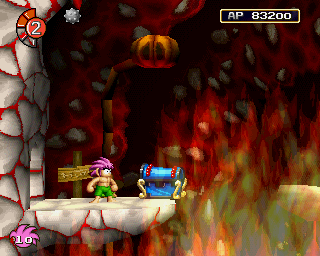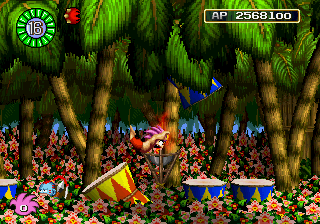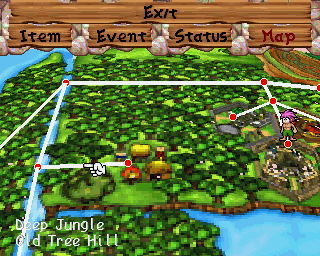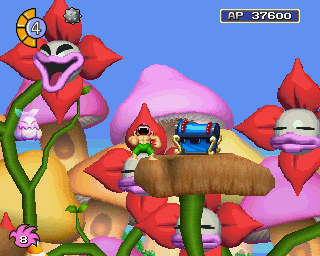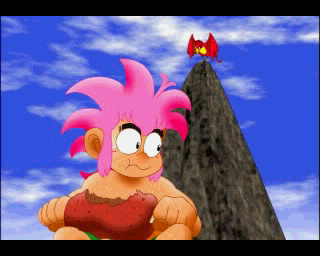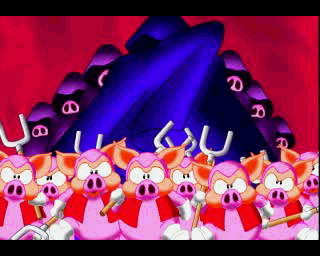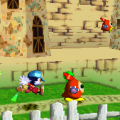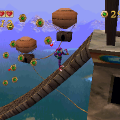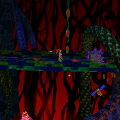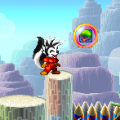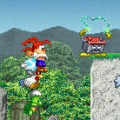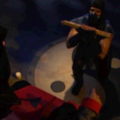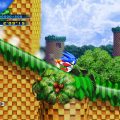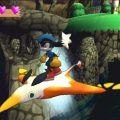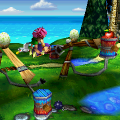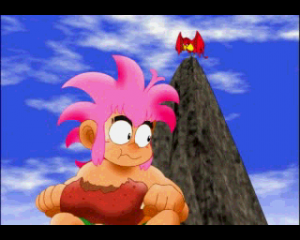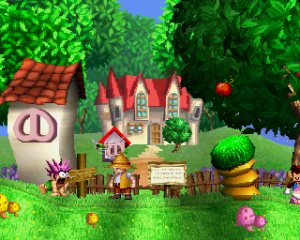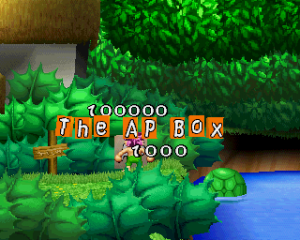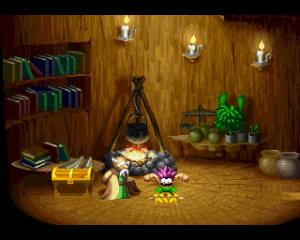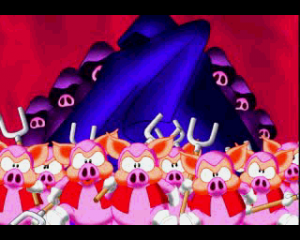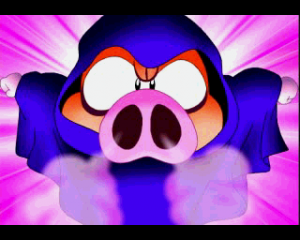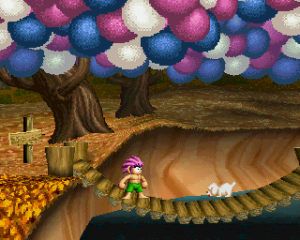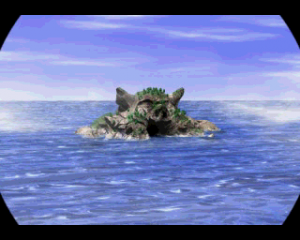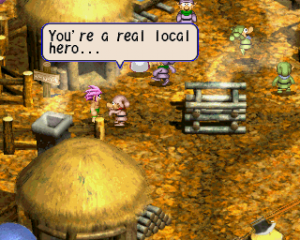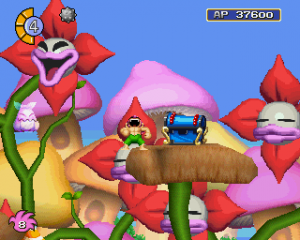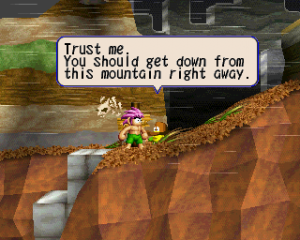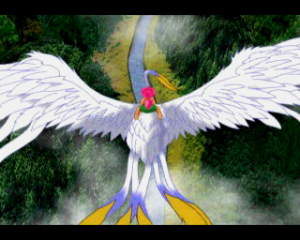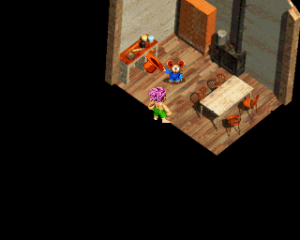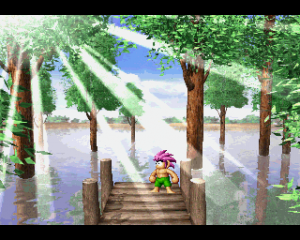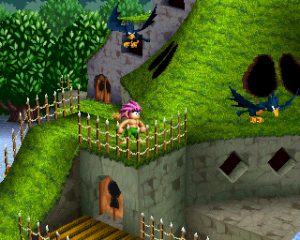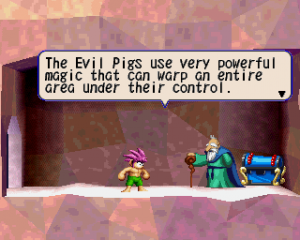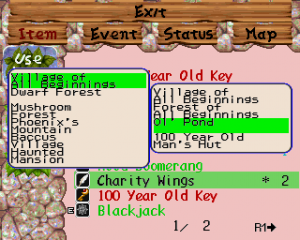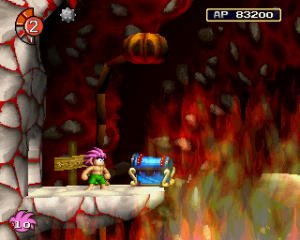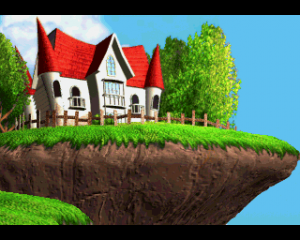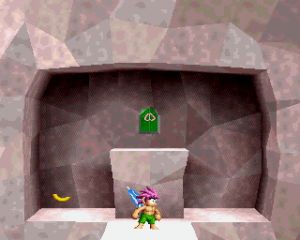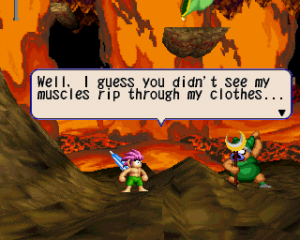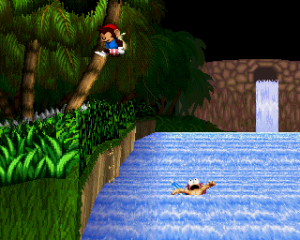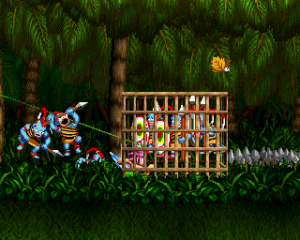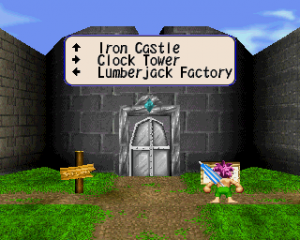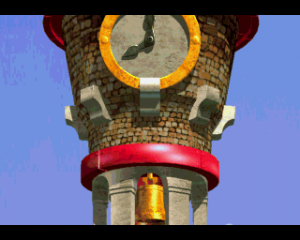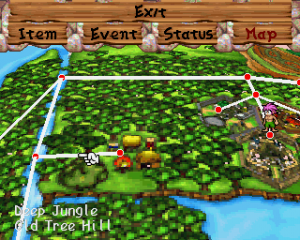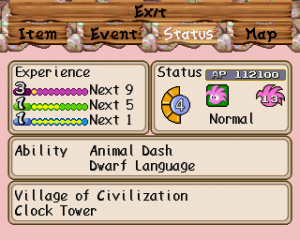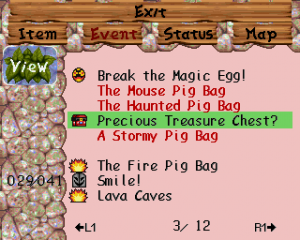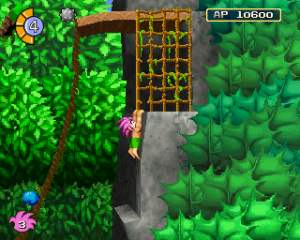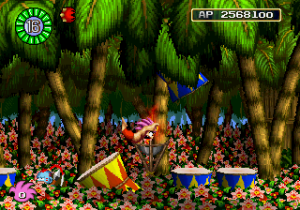Tokuro Fujiwara was one of Capcom’s most respected (and feared) employees. A graduate of Osaka Designers’ College, Fujiwara was recruited by Capcom as a designer and is credited as the creator of the Ghosts ‘n Goblins franchise, as well as producing several Mega Man titles. After working at Capcom for thirteen years, he left the company to form his own studio, Whoopee Camp, to which the only contributions to the gaming world were the two Tomba games. After that, they went bankrupt.
This is a unfortunate turn of events, since the Tomba games are remarkably creative titles, blending a platformer with RPG elements. The player takes control of the titular Tomba, a pink haired feral child arguably based on “kijimuna”, small wood sprites in Japanese mythology with crazy hair and a playful streak. They live in trees and are excellent fishermen, facts which are referenced in the opening cutscene. The name was changed to Tombi! in European countries, probably because “tomba” is Italian for “grave”, which would change the feel of the game somewhat.
Tomba lives “on a certain continent which for some reason has never been marked on any map”. In the beginning of the game, Tomba’s golden bracelet is stolen by a tribe of humanoid pigs called “The Evil Swine”. Since the bracelet is the only remaining memory of his grandfather, who had raised him from birth, Tomba sets out to hunt down the tribe of pigs and get back what is rightfully his.
Fairly early into the adventure, Tomba learns that the reason the pigs collect gold is that it fuels their magic, and that their seven leaders have cast a curse over the continent. The only way to break the curse is to find a pig bag, which is hidden in each of the cursed lands, and use it to capture the evil pig. So basically, Tomba enters a cursed area, finds the evil pig bag, hunts for the portal to the evil pig’s lair, and then captures him. This frees the area from its curse and opens up new parts of the game.
Tomba! is a 2.5D platformer – the characters are sprites, but the backgrounds are polygonal. At certain points, you can climb up or leap off walls, switching to another horizontal plane, though these locations are not always clearly marked. Tomba carries a weapon, which at the beginning can merely stun enemies, so his main method of attack is to jump onto something, bite their necks, bounce around a bit and then throw them around. It takes a little while to adjust to the controls, especially since Tomba arches his back during his jumping animation, and it feels a little floaty compared to other 2D platformers. There are also a handful of towns, which changes the view to an overhead perspective, allowing him to explore more freely.
The big difference between this game and other RPG/platform hybrids lies in the event system. These are missions of various difficulties that appear by either finding them in the levels or getting them directly from NPCs. The events range from specific tasks like “Save seven dwarfs” to the more esoteric “Where did that barrel I put in the river go?”. Sometimes, the players only have the name of the event itself as a clue. Most of the time, clearing an event gives some kind of item or new quest, but some of them, such as the aforementioned barrel quest, are seemingly there to compel players into seeking everything the game has to offer. Unfortunately, the quest system is rather confusing. Although the game keeps track of completed quests, it doesn’t log any currently active quests, nor is there any in-game map of the levels, so it leads to lots of aimless running around.
The game is fairly open, allowing the player to explore the areas freely, although some are closed until a certain evil pig has been defeated or a certain event cleared. In other words, it’s basically a Metroidvania. Altogether, there are 130 events in the game. Normally, mandatory events are fairly easy to figure out, with plenty of hints from NPCs and in the environment itself. The game offers no tutorial, although none is really needed. The only form of help arrives early in the game when the player needs to get rid of some fog covering a forest. The game says to find something windy, and to the player’s surprise, a farmer living in a nearby village mentions having recently ordered a portable tornado from a mail-order survivor kit. Open the mailbox and the fog blows away. And with that, the player can continue on with the game.
Some events are just weird, like the guard standing on top of the stormy mountains. He can only say the word “funga” and does not allow anyone to pass. In the jungle area, more like him are encountered, but as enemies this time. In the jungle something called a “funga-drum” is found in a random chest. Give the guard the drum and he moves, giving the player access to his treasure of…molasses? Nothing about any of this is explained, but the molasses can be given to a witch in the first town, who’s making a potion. This bizarre event with the guard is not necessary to complete the game, but since the witch gives the player one of the best weapons in the game, the player should probably complete it anyway.
There is also a really bizarre quest involving a thief’s treasure. The player talks to him, and he says his treasure is in the chest behind him. He then immediately says he lost it and leaves. The player opens the chest, finds his treasure and the event is completed, mere seconds after it started. Naturally, the treasure is used for absolutely nothing whatsoever.
Clearing these events, even if they give no other reward, yield Adventure Points. These can be used to open AP boxes, which in turn grant new items. These items are everything from clothes that raise the player’s stats, to a variety of weapons. Very few of them are straight upgrades, rather offering a different way to play the game. In the end, the clothes and the weapon the player has from the beginning offer the most utility, unless the levels or an event forces the player to use a certain item. The best weapon is a combination of the default Black Star and the grappling hook, allowing the player to swing on ceilings and walls. Adventure Points can also be used to have the player’s fortune told by two fortune-tellers, but the only thing it’s good for is getting extremely vague clues on which areas contains pig bags.
The overworld map is quite large, but by using something called charity wings, Tomba can warp to any area previously visited. After solving certain events, the player will obtain Baron, a dog that flies with its giant ears and allows Tomba to warp around free of charge.
There’s also an experience system in place. When you defeat enemies of different color types, the player gains a level in that color. When the player gets to level ten, they can collect one of three hidden crystals which give them elemental powers. However, the powers are so limited that there’s no reason whatsoever to grind enough to get them. Unfortunately, collecting them constitutes the solution to three events. However, there is an event that gives the player fish food which can be put in random ponds to lure out a fish that levels them up automatically, saving a lot of grinding.
The game keeps track of lives, but the game is fairly easy and the player is able to stack up about twenty extra lives by the end of the game. The player can also save whenever they wish by going to the signpost at the entrance of each area, making the life system unnecessary. The sequel wisely does away with this system altogether.
Unfortunately, the boss battles are kind of a pain. In order to defeat them, you need to toss the boss into the pig bag, which ends the fight immediately. The problem is that the pig bag spins and floats all around the screen. You can’t control the direction which you throw enemies, which means that lining up the pig and the bag is almost a matter of luck, especially when the screen is inundated with projectiles. This causes the fights to drag on much longer than they need to.
There is quite a number of charming NPCs. One of the first ones you meet is Charles, a talking monkey dressed like a kid, who is somehow more civilized than Tomba. Throughout the game, you meet a line of increasingly old men, ranging from a 100-year old man, all the way up a 1,000,000 year old man, who gives background information about the evil pigs. Much is made of Tomba’s ridiculous hair and shorts. He stores all his items, even living things, in his belly and throws them up on command. As one point you need to learn the language of the Dwarfs. To do this, you mount them and bite their skulls, which they seem only mildly irritated by! In the final area there’s a small room where the defeated evil pigs are turned to stone and placed on pedestals, which is quite creepy. The music and sound effects range all the way from funny and upbeat to low key and mysterious, and it does a good job at giving the player a sense of wonder and provokes a willingness to explore the game world.
The levels are eclectically themed, including a lava cave, a haunted house, a city dedicated to technology, and a level floating on a lake of what is obviously wine. A drink for grown-ups, the game calls it. One area is filled with weird flowers and a variety of colored mushrooms. The “upper” mushroom will cause the flowers, and the platforms they hold, to rise up, while Tomba cackles maniacally. The “downer” mushroom will make them everything sad, lowering the platforms, and causing Tomba to wail. An amusing dig at Super Mario Bros., if anything.
Though never confirmed, it’s fairly clear to anyone who has a more than passing knowledge of anime that Tomba’s world is inspired by various old-school anime, especially ones from the late 70s/the early 80s. For starters, the islands are similar to the setting in Akira Toriyama’s Dr. Slump, a mostly rural, insular landscape full of little villages, where humans, humanoid animals, talking animals, fantasy and mythical creatures all coexist together. The game has in common with Toriyama’s early work also some scatological tones. Compare Dr. Slump‘s poop and fart jokes with Tomba’s butt-shaped “flowers” that release gas when jumped upon. The Koma Pigs and their snout-shaped symbol could also be inspired by another famous “mascot” of sorts: Odate Buta, the mechanical little pig from Tatsunoko Production’s Yatterman. The robotic pig in a vest is based on the imaginary proverb “even a pig can climb a tree if flattered enough” appeared in the cockpit of the “bad” guys’ robots, usually mocking them before the defeat.
Tomba! has a few animated cutscenes, some of them quite striking, such as a giant tower in the shape of a flower that rises up from the ground. This tower was probably also meant to be a dungeon or something similar, considering it has its own music track, but just consists of a single room. The graphics are very lovely and quite detailed, with several backgrounds layers. Tomba is expressively animated, but the NPCs are a bit stale looking, with a grand total of two animation sprites (mouth open, mouth closed). The intro cutscene has different music in the three regional versions. The Japanese version uses a vocal song called “Paradise” by Tokyo Q Channel. The American version uses the same song but cuts out the vocals. The European version uses the song “No Sweat!” by a band called North & South, which was featured in a British children’s television show around the time Tomba! was released.
The game does feel unfinished in few areas. It’s not an issue that gets in the way, but if the player looks at the event log, there’s a large gap, which hints at cut content. There is also what looks like a village on the world map that cannot be entered. The game is quite long, but it’s both frustrating and confusing seeing cut content being openly shown in the game like that.
Despite its high points, as well as being heavily promoted through a number of demo discs, Tomba! sold poorly. It’s best experienced as an enjoyably kooky platformer with a somewhat tedious method of finding and fighting bosses. But beyond these small issues, this game is very well worth it.
